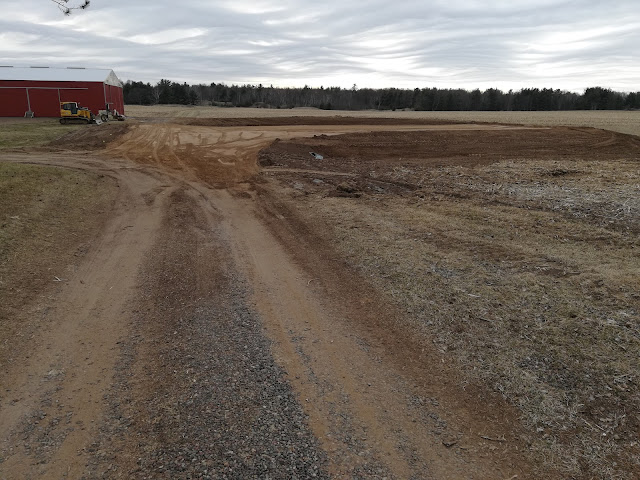The corn (Organic Viking Seed variety O.58-85P from Albert Lea Seed) was planted 33,000 seeds/acre, 2.5 inches deep, on 6/1/22.
I have a Deere 9560sts combine with a 693 corn head that has the Calmer stalk chopping rolls in it.
_______________________
The yield looks a little lower than average, around 125 bushels/acre, but I won't know total yield/acre until I get the final settlement statements from the buyer.
- UPDATED to say that the statements show the corn had a test weight of 52.5 lbs/bushel and was at 20% moisture. They pay me $11 for a bushel weighing 56 pounds at 15.5% moisture. So there were deductions from the gross amount I got from the buyer, as I was selling him corn that didn't make the spec.
To give you some way to make sense of this, last year, on a different parcel, we got about 160 bushel/acre. A couple of my conventional/chemical neighbors have told me their yields were down about 25% this year, due mostly, in their opinion, to lack of timely rain. (The average yield reported by conventional/chemical farmers in Polk County, WI for 2021 was 159 bu/acre. I seem to remember that the average organic yield for the county was around 120 bu/acre.)
Another thing that could have affected my yield was the fact that I couldn't get last years red clover cover crop terminated soon enough. Due to heavy spring rains, the lime and turkey litter couldn't be spread into the standing clover in a timely manner, causing the tillage pass that kills the clover to be delayed until right before I planted the corn. I've been told that unless the clover is killed at least 3 weeks prior to planting the corn, the exudates (?) in the dying clover will suppress the emerging corn plants.
Some relevant numbers:
- One bushel of corn weighs 56 lbs.
- An acre has 43,560 square feet, the same as the area of a square 208 ft by 208 ft.
- There are 2.47 acres per hectare
Using the above, the yield of 125 bushels/acre = 7.9 tonnes/hectare, if I did the math right.
______________________________
There are a few foxtail, pigweed, lambsquarters, and velvetleaf in the endrows, but overall, the weeds look under control.
I was only able to get two semi trucks a day here, as they are in high demand this time of year. Each truck trailer will hold about 1100 bushels (weighing 61,000 lbs/28,000 kg), that comes off of a little less than 8 acres (approximately 3.25 hectares) of corn, so it took a while to get the 90 odd acres harvested. Ultimately we filled 11 trailers with the corn.
I pay to have the corn delivered to the buyer, Cashton Farm Supply in Cashton, WI, about 175 miles away. All things considered (price, currently $11/bushel; distance that I have to truck it; ability to take wet corn, i.e. above 15% moisture) they are the best buyer of organic corn that I've found.
______________________
The combine engine de-rating fault codes didn't happen again, so we were able to get the corn all combined without too much trouble from the combine.
#1 - AOO 676 05#2 - AOO 1569 31#3 - AOO 412 00Basically all three are related to high temperature sensors or actual high temps in either the coolant or the exhaust manifold.
The combine will need to be serviced by the dealer next spring/early summer, when they can hopefully figure out what is going on.
_______________________
On the last day of combining the tractor, a Case 7140, that we were using to pull the grain cart stopped working. We think it's a problem with the fuel system. Fortunately we were able to rent a big enough tractor from a neighbor that we could use to pull the grain cart. The Case is still out in the field and will have to be hauled into the dealership to get fixed. I was thinking about selling that tractor (and replacing it with something like a Deere 8410) prior to this event and I'll pursue that further this winter.
Prior to starting combining, there was about 5" of snow on the ground that started to melt due to warm temps. By the last day of combining there were some wet spots that I had to avoid with the combine for fear of getting stuck. Because of that I had to leave a small amount of corn unharvested.
Next spring we'll work on making that equipment crossing field entrance ramp, shown in the second video, less steep. A couple loads of gravel should do the trick. Once that's done the semi's can get directly into, and more importantly, out of the field without worrying too much about getting stuck.
This is the last of the major work this season. After we were done I blew everything out with the leaf blower (residual grain in the equipment attracts rodents who chew on wires) and then drove the combine and grain cart home, just ahead of the first major snow storm of the year. I was able to get everything put away in the sheds and the doors shut just in time.



























.jpg)
.jpg)
.jpg)



